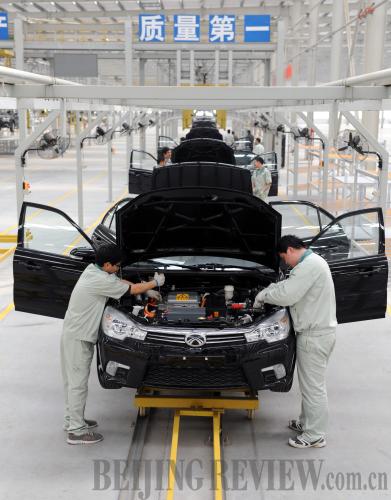|
 |
|
EV PRODUCTION BASE Workers assemble components at a workshop of Xinneng Electrical Vehicle Co. Ltd. on April 16. The company is located in Xinxiang, central China's Henan Province (LI BO) |
Growth Driver
Strong domestic demand has become a driver for the increasing growth in East Asia, according to a World Bank report.
Driven by strong domestic demand, the economies of developing East Asia and the Pacific continue to be an engine of global growth, growing at 7.5 percent in 2012—higher than any other region in the world, according to the World Bank in its latest analysis of the regional economy. As the global economy recovers, the World Bank report projects that regional growth will rise moderately to 7.8 percent in 2013 and ease to 7.6 percent in 2014.
"The East Asia and Pacific region contributed around 40 percent of global growth in 2012, and the global economy continues to rely on the region's growth, with investor confidence surging and financial markets remaining solid," said World Bank East Asia and Pacific Vice President Axel van Trotsenburg. "Now is the time for countries to focus on helping the remaining poor, with more and better quality investments to accelerate inclusive growth."
Fiscal and monetary policies to boost consumption and investment helped sustain growth in 2012 across the region, with middle-income countries performing particularly well. Developing economies excluding China grew 6.2 percent in 2012, up from 4.5 percent in 2011.
In China, growth slowed to 7.8 percent in 2012 due to rebalancing efforts, while the real disposable income of urban households rose by more than 9 percent, supporting household consumption, which contributed 4.4 percentage points to GDP growth. China is projected to grow 8.3 percent in 2013 and 8.0 percent in 2014, said the report.
Boosting Exports
The 113th Canton Fair opened in Guangzhou, south China's Guangdong Province, on April 15, with the aim of boosting Chinese exports and promoting the integration of the country's economy with the world.
The opening comes amid China's economic slowdown but a 13.4 percent growth in foreign trade in the first quarter of the year, much higher than the growth rate of 6.2 percent in 2012.
Nearly 25,000 companies, including 562 from 38 countries or regions are attending the fair.
The fair, or China Import and Export Fair, will further promote the integration of the country's economy with the world, the stabilization of exports and expansion of imports, said China's Vice Minister of Commerce Li Jinzao.
About 200,000 overseas buyers are expected to attend the fair, which will last until early May.
Off With Barriers
During the Second China-U.S. Governors Forum held on April 16 in Tianjin, Chinese officials have called on the United States to reduce barriers to Chinese investment and turn to talks and negotiations to tackle trade disputes between the two sides.
"Protectionism has been surging recently in the United States, resulting in a tightening investment environment," Zhang Qingwei, Governor of Hebei Province, said at the forum.
The United States has launched a series of punitive measures against Chinese investors, including photovoltaic enterprises and tire manufacturers, Zhang said. "Chinese investor confidence can be dampened by America's punitive measures, and it's vital to build up a negotiation mechanism to enhance bilateral trade relations."
Similar concerns were also voiced by Su Shulin, Governor of Fujian Province.
Chinese investors have failed to enjoy equal treatment with Western companies and are facing restrictions in certain industries, Su said, adding that it is even more difficult for China's state-owned enterprises to obtain approvals from the U.S. government.
More and more Chinese firms are exploring overseas markets, and the United States should lift restrictions on Chinese investment, which, in turn, could bring jobs and growth to the target country and create a win-win situation, said Huang Xingguo, Mayor of Tianjin.
Visiting governors from the states of Iowa, Wisconsin and Virginia have welcomed Chinese investors and expressed their hopes that the two nations can increase cooperation in agriculture, trade, culture and education, as well as on issues like food safety and environmental protection.
"We'll continue to look at how we can bring those barriers down. Some of them need to be addressed at the national level by our federal government, but we'll do what we can to make it easier for direct investment in our state," said Governor of Iowa Terry Brandstad.
"We'll get our national government to make the process of getting a visa easier," he added.
The China-U.S. Governors Forum is a groundbreaking measure to enhance cooperation at the provincial and state levels between the two countries. The first forum was held in Salt Lake City, Utah, in July 2011.
| 